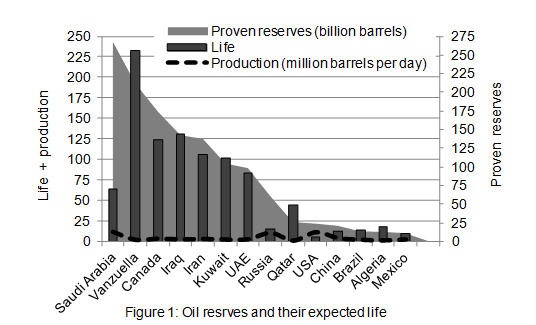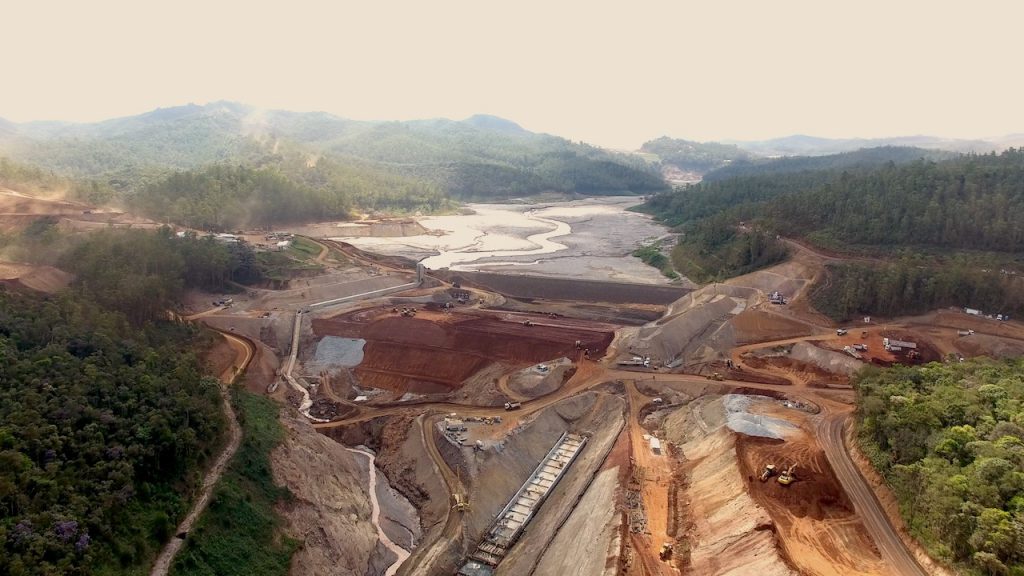Athabasca oil sands: A blessing or nuisance?
Athabasca oil sand deposit (AOSD) is world’s largest unconventional reserves of crude bitumen with a potential of about 1.69 trillion barrels of crude bitumen making up 98% of the total Canadian oil reserves.
These reserves enable Canada standing third in the world after Saudi Arabia and Venezuela as we talk about crude oil reserves. Crude oil accounts for 40% of Canada’s energy demand and 15% of Canada’s merchandise exports.
The total production of AOSD is estimated to be 3.858 thousand barrels per day showing minimum life expectancy of 125 years if extracted at the same rate (Figure1).
Right now, Canada exports 2.130 million barrels per day in addition to 1.8 million Canadian consumption. The oil sands are adding sufficient revenue to the economy and proved the main survival of the economy in the worst case scenario (recession period – 2008).
Everyone should agree with Keith Schaefer statement that “many of the oil sands workers are Maritimes, but it’s also true that the jobs in “Fort Mac” have saved rural areas across all of western Canada from big unemployment”. Alberta mining, oil & gas industry is providing 151, 110 jobs related to multi-disciplinary professions.
It is forecast that the employment in the mining and oil and gas extraction is expected to raise an average rate of 2.2% from 2011 to 2015.The capital spending is $17.2 billion and the industry collects $36.7 billion revenues.
The total proved reserves of crude oil in North America are estimated to be 208.91 billion barrels including Canada; 175 billion barrels, United States of America (USA) ; 23.267 billion barrels and Mexico;0.42 billion barrels.
USA is one of the world’s largest consumer of crude oil with a consumption of 18.8 million barrels per day (MMbd) but poor reserves (3%). The life expectancy of USA resources is very low in comparison to other oil producing generation (Figure 1).
Canada is the leading US’s crude oil supplier exporting 25% (2.23 MBpd) of its oil need (2011) and then Saudi Arabia 14%.
In the case, the USA entirely relies upon its own resources and it may not survive long enough if no exaggeration in the expected reserves.

Source: EIA; US Energy Information Administration 2012 (Independent Statistics and Analysis
USA per day demand is quite high importing 7.5 MBpd. It seems difficult for one or two country fulfilling this high consumption which may certainly increase in upcoming year due to its low reserve capability. The extension of XL Keystone pipeline is a wise step from Obama Government observing the American daily demand, own reserves capacity and their dependence upon the external resources.
Athabasca Oil Sand deposit is important to Americans the same as Canadians and world as well. China and Japan the two large oil consumers do not have much reserves and these countries would have to rely more on other countries in future fulfilling their oil demand. No doubt, Saudi Arabia has highest oil potential (11.545 million barrels) in the world.
Its consumption is less (3MBpd) but the production rate is quite high (11MBpd) and even more than USA (10.13 MBpd). In this scenario, Canadian reserves (oil sand) seems more consistent after Venezuela and Iraq (Figure 1). By the next few decades, it is expected that these reserves may attain more importance taken into account the world’ s proven oil reserves, production and demand scenario.
Regarding green house gases (GHG) emissions, Canada contributes about 2% to the global GHG emissions, out of which 0.1% of the global emissions emit from the Canadian oil sands.
The Canadian two percent global emissions is a combination of transportation (27%), energy extraction sector (28%), oil sands (6% – well to wheel), electrical generation (17%).
The big source of oil sand global emissions emit after consumption from vehicles’s tail pipe. The tailpipe GHG emissions do not vary with the origin of the crude either the gasoline is made from Saudi light crude, West Texas Intermediate crude, heavy Venezuelan crude or Canadian oil sands.
Many other resources need more attention on priority in comparison to oil sand, e.g., GHG emissions from European electricity generation 30 times more than the oil sands contributing about a quarter of EU GHG emissions. Likewise, the GHG emissions from the hydropower generation are seven times stronger in Germany than oil sand.
If we talk about the third world countries, no one exactly forecast the resources of GHG emissions and even their severity to the environment taken into account the management scenarios.
On the other hand, the Government of Canada is well aware about any raised issue relating to extraction of oil sand tailings and it takes steps to come up with those issues, tighten the legislation like Directive 074 and forcing the oil industry to do their maximum minimizing the environmental effects.
In light of this, the oil sand industry is making significant effort for the reduction of per barrel emissions of oil and it is succeeded reducing the GHG emissions per barrel by 26% between 1990 and 2010.
Right now, Canada and other countries are focusing more on efforts introducing the renewable energy resources minimizing the carbon emissions to the environment, despite that the International Energy Agency’s World Energy Outlook for 2012 expects that the world oil demand may grow up at the rate of 0.5 % per year until 2035 and the global economy would have to rely more on oil than any other source.
The total proven reserves of the world are estimated to be 1474 billion barrels with an oil production of 87329 thousands barrels per day.
These presumed reserves are sufficient only fulfilling the world’s oil need for four to five decades if the same rate of production continues and no more reserves are explored.
{{ commodity.name }}
{{ post.title }}
{{ post.date }}

Comments